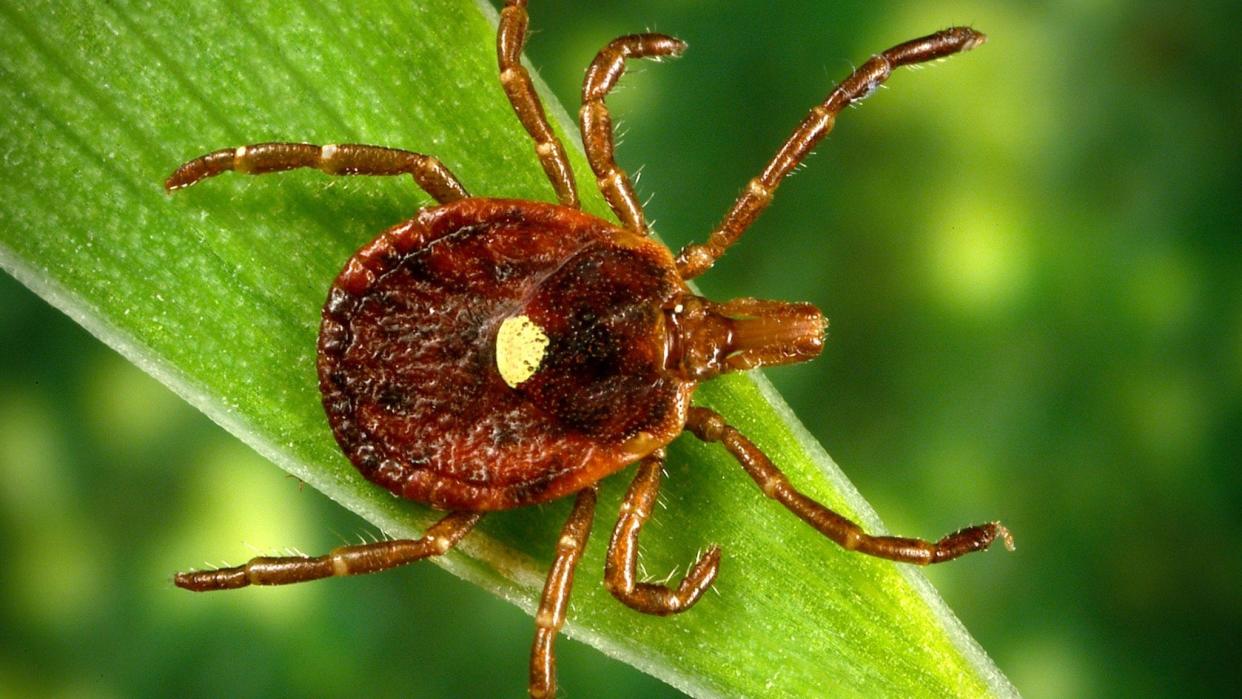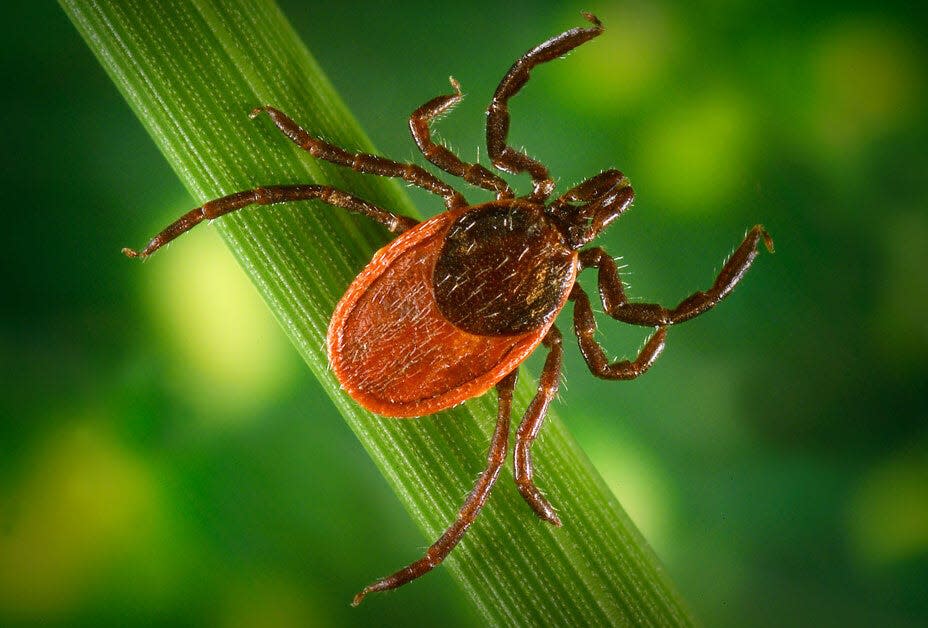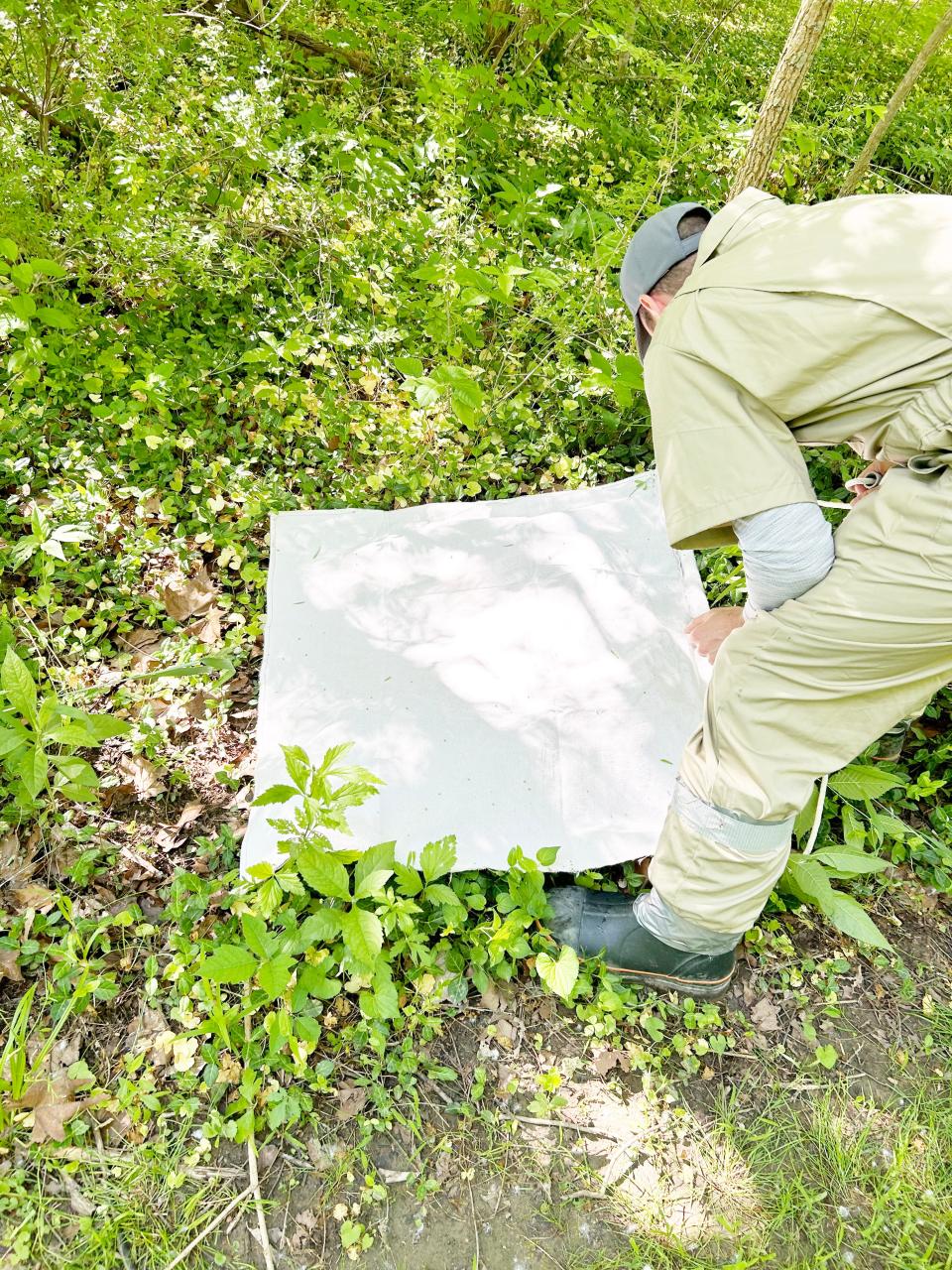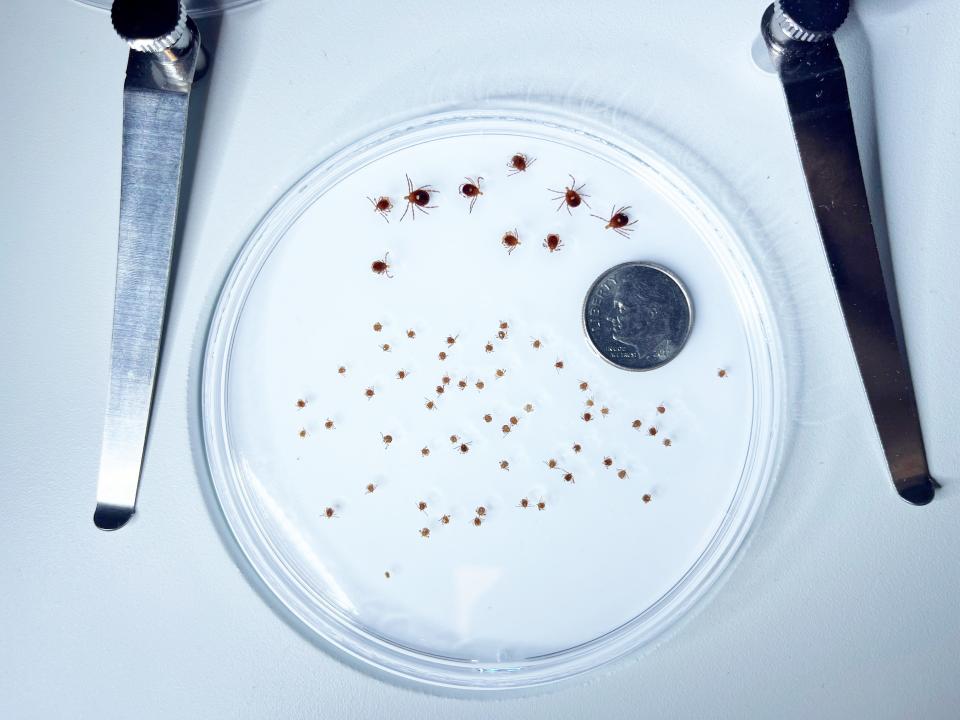These 6 ticks found in Indiana can make you sick. What you need to know this summer

In south-central Indiana, that little black speck on your arm or leg might not be a mole or freckle. It might be a tick that can transmit diseases and make you sick. Anyone who has been outdoors or has pets may come into contact with more ticks than they realize in the spring and summer months across the Hoosier state.
"June is still really high for nymph black-legged ticks," said Lee Green, senior medical entomologist at the Indiana Department of Health. Black-legged ticks transmit Lyme disease, among other pathogens. The nymph ticks transmit the most diseases to people, Green said, because they are harder to find since they are so small.
What tick species spread disease in Indiana?

Indiana has six ticks that spread diseases and illnesses to people. Each of them has more than one pathogen that they can spread.
The American dog tick spreads Rocky Mountain spotted fever and tularemia.
The black-legged tick spreads Lyme disease, anaplasmosis, babesiosis and Powassan virus.
The brown dog tick spreads Rocky Mountain spotted fever.
The Gulf coast tick spreads Rickettsia parkeri; no cases have been reported in Indiana.
The lone star tick spreads ehrlichiosis, tularemia, Heartland virus, Bourbon virus and southern tick-associated rash illness. The tick also transmits alpha-gal syndrome, which makes people allergic to red meat and other products made from mammals. This syndrome can cause severe reactions without any advance warning.
The Asian longhorned tick is a new invasive species that's been found in four southern Indiana counties. While there are no reports of it transmitting disease to people yet, it is a carrier for Rocky Mountain spotted fever as well as Heartland and Powassan viruses.
Symptoms of illnesses caused by tick bites range from fever and headache to nervous and gastrointestinal system disruption. Lyme disease is the most commonly reported tick-borne illness in both Indiana and the United States. Most people infected with Lyme disease will develop a "bulls-eye" rash in addition to fever, chills and fatigue. If left untreated, Lyme disease can spread to the joint, heart and nervous system.
Newly found in Indiana, Asian longhorned tick a threat to livestock
The Asian longhorned tick is a big problem for livestock, which the tick seems to prefer over people. The female tick can reproduce without a male and lays about 6,000 eggs at one time. When enough ticks attach to cattle and other livestock they can kill through strangulation. "It literally can suck cattle dry," Green said. "It's really pretty rough."
So far, the Asian longhorned tick has only been found in Spencer, Debois, Switzerland and Ohio counties in Indiana. Green said officials are closely watching for the tick, especially since it can be spread by many animals including deer, birds and farm animals including pigs, chickens, sheep, goats and cows.

Which ticks are in Monroe County right now?
Kody Clark, environmental health specialist with the Monroe County Health Department, began "collecting" ticks in May at Flatwoods Park, Jackson Creek Park, Karst Farm Park, Riddle Point Park, Switchyard Park and Griffy Lake Nature Preserve. By using a white cloth that's dragged along the ground, he has covered about 4,860 meters (or approximately 5,315 yards) and collected 178 ticks. It took 7-10 hours at each location, Clark said, adding he received training last year from the Indiana Department of Health.
This May was his first time using the drag cloth. He found:
Lonestar Tick Adult Female – 25
Lonestar Tick Adult Male – 18
Lonestar Tick Nymph – 122
American Dog Tick Adult Female – 5
American Dog Tick Adult Male – 6
Blacklegged Tick Nymph – 1
Ixodes Dentatus Nymph (rarely feeds on humans and not of importance to public health) – 1

Clark plans to repeat the process this fall. He said some ticks in Indiana remain active even into the winter months as long as temperatures are above freezing.
Prevention of tick bites starts before you go outside
The time to start preventing ticks from hitching a ride and potentially biting you begins before going outdoors. The state Department of Health website has these suggestions:
Know where to expect ticks, which includes grassy, brushy or wooded areas — even in your yard or neighborhood.
Treat your clothes and outdoor gear with 0.5% permethrin. Permethrin is an insecticide that's used to rid people of lice as well as ticks. The best prevention is to spray permethrin on your clothes hanging up outdoors and let the chemical dry. Permethrin shouldn't be applied directly to the skin.
Wear EPA-registered insect repellents containing DEET, picaridin, IR3535, oil of lemon eucalyptus, para-menthane-diol, or 2-undecanone. Always follow product instructions. NOTE: Do not use insect repellent on babies younger than 2 months and oil of lemon eucalyptus or para-methane-diol on children younger than 3 years.
Reduce the amount of exposed skin by wearing long-sleeved shirts, long pants, hats, socks and shoes that cover the entire foot. Tucking your shirt in and stuffing your pantlegs inside socks helps, too.
While you're outside it's best to walk in the middle of trails, away from grass and bushes, and to re-apply insect repellent. Also, wearing light-colored clothing helps you spot any ticks crawling up your pants or on the back of your shirt.
After you're back inside, the best way to ensure you don't have a tick attach itself to you is to put all your clothes in a hot dryer on tumble for 20 minutes and take a shower, inspecting yourself afterward. Don't forget to check pets or any gear you had outdoors as well.
What to do if you find a tick
If you do find a tick, the state Department of Health website says it's best to remove it using tweezers or a tick-removal tool, grasping the tick as close to the skin as possible. The idea is to remove the tick quickly using steady, even pressure, not jerking upward. Clean the area with soap and water or alcohol.
Once it's removed, put the tick in alcohol, place it in a sealed bag or container, wrapping it tightly in tape. You can flush it down the toilet, but it might be better to keep it so you know what type of tick it is, in case you have a reaction.
If you develop a rash or fever within several weeks, see your health care provider and make sure you mention the tick bite.
Contact Carol Kugler at ckugler@heraldt.com
This article originally appeared on The Herald-Times: What to know this summer about avoiding tick bites in Indiana

